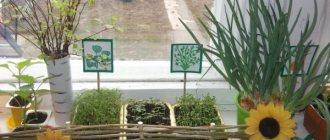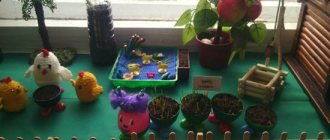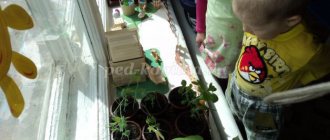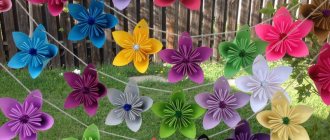Master class on decorating a vegetable garden on a window in the kindergarten “Dachka in Romashkovo”
This spring, according to tradition, our kindergarten held the “Vegetable Garden on the Window” competition.
They suggested an unusual topic - “The plot of my dreams.”
Since our group is called “Romashka,” our children from the preparatory group and I decided to call our garden plot “Dachka in Romashkovo.” We presented our dream dacha like this.
They built a two-story mansion (they took boxes as a basis, covered them with brick-like wallpaper, glued the windows, covered the roof with self-adhesive paper, made balcony railings from ceiling tiles and decorated the railings with trim made from egg cartons, and the foundation was made from shells).
In the vegetable garden area, a design approach was used: the arrangement of the beds and paving slabs is in the shape of the sun.
In the recreation area, flower beds were laid out, a gazebo was built, and a path made of shells was laid out.
We wanted trees to appear on our summer cottage, and we presented them in this form. To do this, we placed birch branches in the vase in advance so that they would produce leaves. The trunk was made from a paper cone, and a bottle of water was placed inside to prevent the branches from withering.
We paid great attention to creating the composition, and at the same time tried to present the variety of seedlings.
And this is our mini-laboratory. The children and I planted onions and observed their growth, and when they grew, we cut the greens and all ate them together with pleasure.
We observed the germination of bean and pea seeds (in cups). We watched the weather. We made notes in observation diaries.
We selected didactic games and coloring books for the children according to the topic, and held discussions on the topic. Then we planted our seedlings in the garden bed and watched the plants grow. At the end of summer we harvested beets, carrots, zucchini, peppers, but the fruits of our labor were shown to other kids, since our students had already become schoolchildren. I am sure that the knowledge and skills acquired in the process of such work will not pass without a trace.
Mini-garden on the windowsill
Sections: Technology
Blizzards are playing out in the yard, and in the group, on the windowsill, spring is taking place. A mini-garden appeared here, bringing joy to everyone in the kindergarten, young and old. Window beds are not famous for their abundance, but for the possibility of live communication with plants. Anyone who starts such a vegetable garden will certainly become interested in experimentation and eco-design. In general, a mini-garden is a fun and useful activity.
I arranged the winter garden with great creativity: I designed it in the form of a farm, decorated it with suitable buildings and decorative accessories. A miller works at the mill, the housewife manages the garden, a scarecrow guards the crops, butterflies, birds and bees delight the eye. In honor of these workers, I named my mini-vegetable garden “Bee”.
The windowsill is a great place for growing a small home garden. The process of growing fresh herbs on a window is simple and requires almost no material costs, but it is so much fun and beneficial. You can grow a significant range of crops on windows: greens, legumes, root vegetables that bloom right on the window (carrots, beets, potatoes), aromatic herbs.
Why do you need a vegetable garden on the window? When garlic, onions, cucumbers, and lemon live on the window, their variety of colors pleases and relieves stress. In addition, they not only warm the soul, but are also good for health. If garlic grows indoors, you will forget what the flu is.
Growing vegetables in kindergarten is also beneficial because it develops curiosity and observation in children, helping them to better understand the life of plants. Methods for observing plants should be selected taking into account the age of children and their individual characteristics. Growing something from a seed will be interesting even for the smallest children; you can even measure the sprouts every day with a ruler and record the data obtained in a specially designed book for observations.
How to arrange a vegetable garden on a windowsill? What might this require? First of all, the desire to do all this! And also:
- Containers.
- Priming.
- Watering can, spray bottle, scoops of different sizes.
- Aprons, gloves.
- Seeds.
- Decor items and a little imagination.
Currently, aromatherapy is very popular, I propose to arrange a fragrant bed on the windowsill, on which you can easily grow:
Green onions. It is better to plant it in the ground. This way the onions will produce crops all winter. If you decide to follow your grandmother’s experience and set up a “water” garden, change the water once a day. This way the onions will not rot and will not give off an unpleasant odor.
Dill. Fragrant herb is a spice known to everyone. Dill requires sun and warmth. Once a week you need to loosen the soil. Goes well with parsley.
Parsley. This young lady tolerates cold well and loves humidity very much. Grows on a windowsill in winter, provided it gets enough sunlight.
Your windowsill will be perfectly decorated with decorative parsley (curly).
Basil. This excellent seasoning grows quietly on the windowsill and does not require any special care. Decorative basil will look luxurious on the windows; purple plants are the most fragrant. For asthmatics, basil makes breathing easier, and for those who eat it regularly, it protects them from stress.
Arugula. Popular salad herb. It sprouts almost instantly, and after 20 days you can eat. It loves the sun very much, so it requires artificial lighting.
Rosemary. Amazing seasoning. It grows in a flowerpot for years; only in the summer, if possible, plant it in the garden. The fragrant bush is very useful and is used as a seasoning.
Mint. My favorite aromatic herb. Do you know how delicious it is to drink mint tea with lemon in winter? Water this bush regularly and a calming aroma will settle in your group.
A collection of seeds, collected in a decorated box, helps introduce children to the variety of seeds and vegetable crops. The collection is available for children, they act with the seeds as they wish (look at, smell, sow, water and observe).
Well-groomed vegetable crops in neat dishes look elegant and go well with most decorative indoor plants. They decorate the room and can provide aesthetic pleasure.
Each of us strives to create a pleasant environment around us, filling it with our favorite aromas. To do this, you can use what nature itself provides: flowers, herbs, spices, seeds. I use what I managed to grow myself: herbs, dried flowers, plant seeds.
All plants have magical properties, have positive energy and cleanse rooms from harmful influences. Since ancient times, the tradition of sewing herbs into fabric has been passed down to give clothes and linen a pleasant aroma and protect them from bad influences. Later, to prevent dry plants from scattering, they began to sew fabric bags in which various herbs were mixed. The aromatic bags are called sachets; they can have different shapes (heart, bag, fruit, pillows).
Nowadays, the sachet serves as a source of freshness and decoration for the home, office, and car.
DIY sachets can act as herbal amulets.
Planted a vegetable garden, look what grows!
Look what's growing!
We will look after
Let's go for the sprouts
On March 2, the traditional competition “Mini-garden on the window” was held at the Moscow Regional Administrative Educational Institution No. 158 in the city of Tyumen. There is still snow outside the window, and in every age group there is a green vegetable garden on the window sills. How much imagination, imagination and creativity the teachers and parents put into it! To make the mini-garden attract the attention of children, various themes were used. This is how the plot from the fairy tale “Kolobok”, a village courtyard, the family of the funny “Cipollino”, a ship with small boats and much more appeared.
We are very glad that parents responded with great desire to help with gardening in groups. Using their skills, the parents tied the jars, giving them the appearance of funny little people, sewed and filled nylon animals with oats: bears, frogs, mice, squirrels, etc., turned plastic bottles into boats, built a wonderful village house, wove wickerwork with sunflowers etc. The vegetable gardens turned out to everyone’s surprise, just a sight for sore eyes!
We are very glad that parents responded with great desire to help with gardening in groups. Using their skills, the parents tied the jars, giving them the appearance of funny little people, sewed and filled nylon animals with oats: bears, frogs, mice, squirrels, etc., turned plastic bottles into boats, built a wonderful village house, wove wickerwork with sunflowers etc. The vegetable gardens turned out to everyone’s surprise, just a sight for sore eyes!
Children look after and observe the planting of garden and flower crops, and then in the album “We planted a vegetable garden, what grows in it?” make sketches of planted vegetable and grain crops: beans, peas, beans, carrots, beets, parsley, their seeds and root crops grown, potatoes, tomatoes, oats, wheat, etc.
The photo report was prepared by: Marina Viktorovna Krapivina, deputy head of the Medical Educational Institution No. 158 of the city of Tyumen
No wonder winter is angry,
Spring is knocking on the window
And he drives him out of the yard...
Pupils of MADOU kindergarten No. 118 in the city of Tyumen felt the arrival of spring in all its glory!
The creative teaching team did their best for the children! Poplar and birch trees have put out their leaves on the window sills in the group rooms. In the gardens created by the hands of teachers and children, dill and peas sprouted. Children with great pleasure replenish their supply of vitamins with green onions grown by themselves!
“Village Compound” - teacher Popova E.L.
“At Masha and the Bear” - teacher Zlobina N.V.
“Vegetable garden all year round” - teacher Shustova A.G.
“Pleten” – teacher Galimova M.I.
Photo report prepared by: Elena Vasilievna Suetina, Deputy Head of Education and Resource Management of the Medical Educational Institution, Kindergarten No. 118, Tyumen
MAOU Byzovskaya primary comprehensive school, department of preschool education (Uporovsky district)
After looking at the information about the photo exhibition “Planted a vegetable garden, look what’s growing!”, the teachers of our small kindergarten, O.N. Medvedeva and L.A. Zhenikova, decided to decorate their vegetable gardens on the window, and this is what they came up with.
Senior teacher T.V. Smagina
In March 2012, the project “Vegetable garden on the windowsill” was held at the kindergarten No. 59 in the city of Tyumen. In each age group, “vegetable gardens” were created where children could observe the growth of plants.
Target:
To generalize and expand the knowledge of preschoolers about how to care for plants indoors; involve as many children as possible in the project; make the project a co-creation of the teacher, children and parents.
Results:
video clip from the teacher of kindergarten No. 59 in Tyumen, Larisa Mikhailovna Koksharova
Author of the photo report: Deputy Head of the Ministry of Internal Affairs of MADOU d/s No. 59 of the city of Tyumen, Bagaeva Tatyana Nikolaevna
We invite teachers of preschool education in the Tyumen region, Yamal-Nenets Autonomous Okrug and Khanty-Mansi Autonomous Okrug-Yugra to publish their teaching materials: – Pedagogical experience, original programs, teaching aids, presentations for classes, electronic games; – Personally developed notes and scenarios of educational activities, projects, master classes (including videos), forms of work with families and teachers.
Why is it profitable to publish with us?
1. 1. “Kindergartens of the Tyumen Region” is an officially registered specialized media outlet at the federal level. EL No. FS 77 – 43321 2. The activities of the editorial office are supported by the Department of Education and Science of the Tyumen Region 3. We issue a “Certificate of Publication” in the media. 4. The document has a unique number, is entered in the register, has the original seal of the editorial office of the online publication and signature. 5. “Certificate of publication” in the media is sent to the author in both paper and electronic versions. In detail In detail >>> Sample “Certificate of publication of author’s methodological material in the media”.pdf
From the editors of the online publication “Kindergartens of the Tyumen Region” All authors of reports in the “Preschool News” section, which are published under an editorial agreement with a preschool educational institution, can order a Sample “Certificate of publication in the media.”pdf Go to the order form >>>
If you are a preschool teacher in the Tyumen region, Yamal-Nenets Autonomous Okrug or Khanty-Mansi Autonomous Okrug-Yugra, you can publish your news material. Apply for a one-time publication of a report, registration and sending of a “Certificate of Publication in the Media”. (Paper or electronic version).
At the end of the academic year, the editors select the most successful works and, together with the Department of Education and Science of the Tyumen Region, encourage the authors with valuable gifts and letters of gratitude.
Cool lifehacks
Creative ideas for organizing a garden in an apartment:
- In order not to miss a single ray of sunlight, an additional mirror is placed in the room or reflective films are glued.
- In winter, you can compensate for insufficient air humidity by placing a damp towel on the radiator. At the same time, the temperature will drop. The heat will be spent on moisture evaporation.
- If the battery is too hot, if it is not possible to regulate the heating, cover it with a piece of polystyrene foam. The material is also used for the opposite purpose - to insulate from a cold window.
- The desired sunlight may be too bright. To weaken the power of the rays, hang blinds or a gauze curtain.
Plant growers believe that apartment conditions in terms of comfort for plants can be classified as cave-like. Despite this, housewives manage to grow, in addition to ordinary herbs, light-loving crops such as tomatoes and eggplants. Balcony cucumbers on the windowsill have become commonplace. It remains to wish those who have taken on this task good luck in an interesting business that can become (or has already become) your hobby.
Did you like the article? Tell your friends about it:
1 1
Vegetable garden on the window in a kindergarten: decoration in the form of a fairy tale, photo
Children spend most of their time in preschool. In part, this is their second home. Through the efforts of teachers, children learn a lot of new things during the day. For greater variety and interest, the program includes creative projects. A vegetable garden on a window in a kindergarten, decorated in the form of a fairy tale, is one of them. Available tools, patience and imagination will help bring ideas to life.
Mushrooms
Mushroom mycelium does not like direct sunlight. It will be more comfortable to plant on the northern and northeastern balconies or a closed veranda in a private house.
Boxes, jars, bags, and wood cuts are used for placement. Planting material is sold together with a nutrient mixture or in the form of mycelium. For the latter, a soil mixture is prepared from sawdust of any trees, except conifers, plant residues, and coffee grounds. The substrate is disinfected in boiling water.
The development of mycelium occurs in the dark at 25°C and constant moistening with a spray. After 2 weeks, white threads should appear. This will be a signal for the temperature to drop to 14-15°C. The darkening can be partially removed, but direct sunlight is excluded.
What grows on the windowsill from mushrooms:
- oyster mushrooms;
- honey mushrooms;
- chanterelles;
- Champignon.
Special requirements
When it comes to young children, it is extremely important to ensure their safety.
- When setting up a mini-vegetable garden on the window, do not forget about the size. They should not go beyond the window sill;
- a safe zone is selected to implement the idea;
- the use of fertilizers is prohibited.
Recommendations
- For a vegetable garden on a window, you need to choose the sunny side; if there is none, you will have to come up with additional lighting.
- Compliance with the temperature regime in the room should not be lower than +17 degrees.
- Mini garden beds require ready-made soil. There is no question of any fertilizers - their use in preschool institutions is strictly prohibited.
Correct lighting
The temperature in the apartment in both winter and summer is favorable for growth, but the lighting is one-sided. The plant only receives enough sun for a few hours. Such conditions, even on the south side, will be uncomfortable, especially for tomatoes, eggplants, and peppers.
In the morning hours on the western windows, and in the north all day long, it is necessary to organize illumination. Phytolamps and LED light sources are economical to use, but expensive to purchase and are effective mainly for green crops.
Let's start creating
Due to their age, the guys still don’t really understand what and how to do. The main responsibility lies with the teacher. It all starts with the design, this is where children can show their imagination. To do this, anything can be used, boxes, plastic bottles and cups. You can’t really accelerate on the window due to limited space. You will have to be content with two beds in order to compare them later.
It is more correct to give preference to large seeds (onions, beans, peas, indoor cucumbers). Children's motor skills can easily cope with them.
Microgreens
Forcing green mass from seeds is optimal for a healthy diet. This method is considered environmentally friendly; fertilizers are not needed for greenery. All the vitamins and microelements that the plant stored in the seeds for growth are transferred to the edible part.
It is not necessary to stock up on heavy soil. Useful greens grow in hydrogel on the windowsill in the same way as in soil. The mass is ready for cutting after 10–14 days. You can sow the same dill, arugula or peas on greens, or you can get a whole complex of vitamins and microelements using a mixture of seeds.
Decor
Children should be directly involved in the process. They may not be able to plant the seed correctly in the ground right away, then entrust them with an equally important task - registration.
When creating a vegetable garden on a window in a kindergarten, do not forget about decorating it in the form of a fairy tale. By the way, you can use your favorite cartoons as an idea. For example, "Masha and the Bear".
If space allows, you can put a whole onion in the water, and very soon the children will see the fruits of their labors and will even be able to taste a fresh green onion for lunch. It’s just that in a jar it will look boring and not aesthetically pleasing. You can cover the container with colored paper, or ask your mother to knit a cover for it, sew buttons on it, they will serve as eyes and nose. The result will be Chipolino.
Using the same pattern as the sun, make a tree and glue it on the window slope, it will be very beautiful. Place animal figures between the mini-beds. It could be anyone, a hare, a cow, a horse.
There is another great idea - make something like a fence from planks or parts of a construction set and attach it to the windowsill with tape. This structure will serve as a front garden. By and large, you can use anything. You can create garden beds in the cars and use Kinder Surprise toys to enliven the free space.
What can you grow from?
Green pets are grown generatively from seeds, seeds and vegetatively - from rhizomes, cuttings, shoots, stepsons, and parts of the stem.
From seeds
The smaller the seeds, the more troublesome it is to take care of the seedlings. It should be remembered that it is permissible to sow dill with seeds from your garden, but it makes no sense to try to get seeds from an F hybrid cucumber. The result will be very different from the source.
From the seed
The growth from the stone appears after stratification or prolonged soaking. Trees obtained from seed may not bear fruit. It all depends on the biology of the plant.
From the aerial parts and rhizomes
This type of propagation is the fastest, because there is a supply of nutrients for the formation of roots or roots for receiving nutrition. The main thing is not to rot the planting material until the plant is formed.
Original design ideas
The older the kindergarten group, the more responsibility for the garden on the window can be assigned to it. Children will be able to cope with clearing mini-beds of weeds and will be able to monitor the temperature and watering. And come up with interesting ideas for decorating a small green corner. Here, their ingenuity and ingenuity will definitely come in handy. Pieces of cardboard can be used under the fence. And place a scarecrow in the middle of the area.
In the corner where cucumbers grow, right on the fence, you can attach bees made of colored paper. Thanks to the efforts of the children working on the design, the vegetable garden on the window in the kindergarten will look like a fairy tale. Every little thing carries a certain meaning. The task of parents and educators is to explain this to the little ones.
At the top, on the window, you can place small flowerpots with flowers. Surely the girls will be interested in looking after them. At the same time, they will gain new information for themselves. For example, some plants like more moisture and predominantly cold watering, others less. And you only need to water them with warm water. Having learned all this, children will be able to independently care for the plant at home.
What are the benefits for a child of having a vegetable garden outside the window?
By creating a miniature vegetable garden on the window, children receive new information. They learn how to care for crops and expand their vocabulary. Previously, terms such as planting, loosening, seeds and others were incomprehensible to them. And now the guys have a clear idea of all this.
You can come up with different addition and subtraction problems. For example: “we planted 6 bulbs, 4 of them managed to germinate and produce a green feather. The question is how many bulbs have not sprouted at the moment.”
These are not all the advantages of this project. Direct participation in planting plants develops a sense of responsibility in children. As they master new knowledge, they independently seek answers to their questions. Thereby enriching your inner world and expanding your horizons.
DIY stuffed animal
When designing your summer cottage, dividing it into zones, we use a huge number of landscape design elements. Modern styles reign in almost every garden, decorating and delighting us with an abundance of fountains and alpine slides. However, you can find gardens where the old styles and customs are still preserved. See all the beautiful flower beds photos here.
Probably everyone has a scarecrow in their garden. He is wearing old trousers and a shirt, and with all his appearance he is supposed to drive birds away from the beds. Nowadays, the scarecrow has become not just a scary element in a gardener’s garden, but also a wonderful addition to the garden.
Garden scarecrow in the country. How to decorate a garden
DIY stuffed animal
Previously, you could find a really scary, disheveled scarecrow, planted on a pole in the center of the garden. Now everyone wants to make something beautiful and neat, and the garden scarecrow has not escaped this trend. In modern gardens there are neatly, one might even say stylishly dressed scarecrows.
From the usual two wooden sticks and a country flower pot you can get a magnificent lady. All that remains is to dress her up and draw a face on the pot, and instead of hair you can use hay or grass planted directly in the pot.
Sometimes crafts are truly touching. For example, a stuffed animal can be made from a children's toy. More precisely, taking her head. A beautiful smiling crow with a straw body, in a beautiful hat with a bright flower and a dress looks simply elegant. True, the question immediately arises as to who such a crow can drive away, rather the opposite.
In the original garden you can find whole groups of stuffed animals. Which looks very colorful and with a touch of humor. As you know, a scarecrow is made from straw; unfortunately, it is not always possible to find enough to create little men. Then ordinary grass can come to the rescue or just make a small scarecrow.
If you delve into the ancient times, you can find out that the scarecrow’s master’s clothes were given for a reason to dress him. It was a kind of ritual. The straw man, dressed in the owner's shirt or pants, took responsibility for the safety of the garden not only from birds, but he also served as a kind of amulet against the evil eye.
Ready-made stuffed animals that are sold in the store
A straw man in country style will look especially harmonious. It will organically fit into the garden and will not only protect it, but also add some zest.
The perfect DIY garden scarecrow
What to grow in
Tomatoes will need a volume of 5–7 or more liters; peppers will need 3 liters per root.
Pots
Large plants are planted in pots - peppers, tomatoes, cucumbers, eggplants.
Containers
It is convenient to grow seedlings in a plastic container for further transfer to individual containers. You can grow mini-greens for cutting, onions for feathers.
Boxes
The boxes are useful for group plantings of microgreens, carrots, and dill.
Bottles
Glass bottles look interesting as containers, but they do not have air access. You can build a vegetable garden from plastic bottles. For five-liter containers, cut off the tops or sides, leaving the neck - the shape depends on the size of the root system. In some plants it is superficial, like cucumbers, while in others it goes deep, like tomatoes and root vegetables.
Tubs
For plants with a large root mass, a tub will be the best option. For example, for tomatoes, potatoes.
All types of containers must have drainage holes. A layer of broken stone, brick or vermiculite, expanded clay is placed on the bottom. Without drainage, oxygen will stop flowing to the roots and putrefactive processes will begin.









